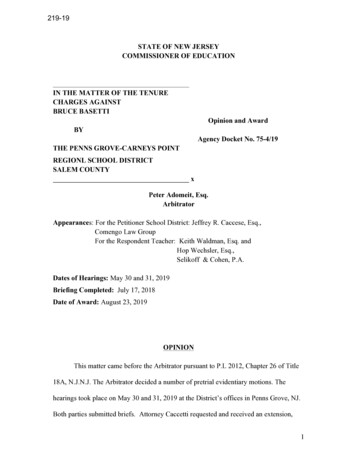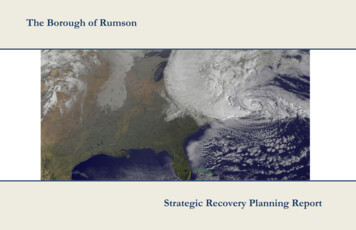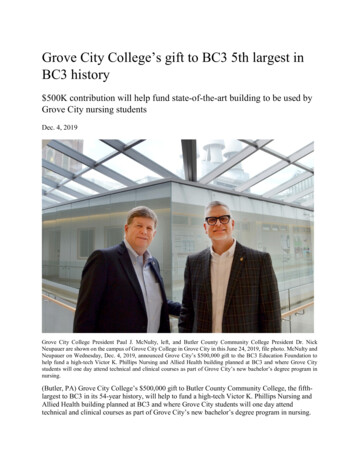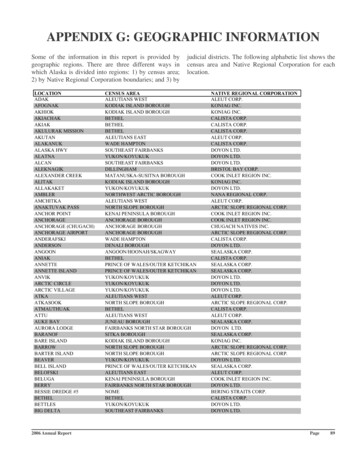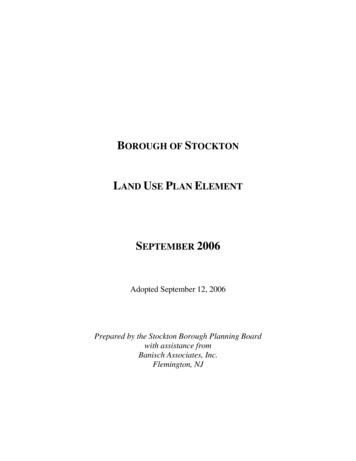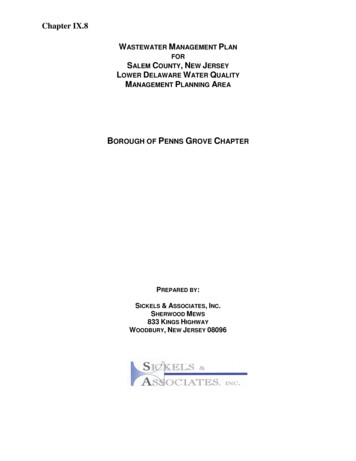
Transcription
Chapter IX.8WASTEWATER MANAGEMENT PLANFORSALEM COUNTY, NEW JERSEYLOWER DELAWARE WATER QUALITYMANAGEMENT PLANNING AREABOROUGH OF PENNS GROVE CHAPTERPREPARED BY:SICKELS & ASSOCIATES, INC.SHERWOOD MEWS833 KINGS HIGHWAYWOODBURY, NEW JERSEY 08096
Chapter IX.8TABLE OF CONTENTSI.INTRODUCTION. 1A.Status of Previous Approved WMPs . 1B.Current Wastewater Services . 2C.Current Water Services . 3D.Overview of Environmental, and Local Considerations to Wastewater Services . 3E.Overview of Water Resource Management Issues . 4F.Overview of Future Wastewater Services. 4G.Summary of Significant Actions . 5II.EXISTING INFRASTRUCTURE AND TREATMENT FACILITIES . 5A.Wastewater Treatment Plant . 5B.Major Transmission Piping and Pumping Stations . 5C.Existing On-site, Non-industrial Wastewater Facilities. 6D.Existing Industrial Wastewater Facilities . 6E.General Wastewater Management Areas for Septic Systems . 6F.Existing Wastewater Flows. 6G.Existing Wastewater Treatment . 7H.Existing Public Water Supply Infrastructure . 7I.Existing Public Water Supply Allocation and Daily Demands . 8III.ENVIRONMENTAL AND OTHER LAND FEATURES . 10IV.DELINATION OF SEWER SERVICE AREAS AND PLANNING INTEGRATION. 11A.Environmentally Sensitive Areas Map . 11B.Sewer Service Areas in Environmentally Sensitive Areas . 12C.Exceptions to the Use of Geographic or Political Boundaries . 13D.Environmentally Sensitive Areas – Data Sources . 13V.FUTURE WASTEWATER DEMAND AND FACILITIES . 13A.Conformance and Nonconformance with Zoning and Prior Land Use Approvals13B.Municipal Zoning and Composite Zoning . 14C.Calculating Future Wastewater and Water Supply Needs and Capacity . 14D.Municipal Demand Projections in Urban Municipalities . 15E.Municipal Demand Projections in Non-urban Municipalities . 15F.Future Wastewater Outside of Sewer Service Areas . 16VI.ANALYSIS OF CAPACITY TO MEET FUTURE WASTEWATER NEEDS . 16A.Adequacy of Sewage Treatment Plant Capacity . 16B.Analysis and Selection of Treatment Alternatives. 17Sickels & Associates, Inc.Wastewater Management Plan forSalem County, New JerseyPenns Grove Borough ChapterPage-IX.8-i
C.D.E.VII.Antidegradation Analysis for New and Expanded Domestic Treatment Works . 17Discharges to Ground Water . 17Adequacy of Dilution To Meet Future Non-Sewer Service Area Demand . 17FUTURE WATER SUPPLY AVAILABILITY . 17A.Sufficiency of Water Supply. 18VIII. MAPPING REQUIREMENTS . 20A.Basis for Service Area Delineations . 20B.Mapping Classification . 21LIST OF TABLESSECTION 1: INTRODUCTIONTable 1.1: Historic PopulationTable 1.2: Projected PopulationSECTION 2: EXISTING INFRASTRUCTURE AND TREATMENT FACILITIESTable 2.C.1: Non-Industrial NJPDES Wastewater FacilitiesTable 2.F.1: Wastewater Treatment Plant Capacity and Flows 2010Table 2.F.2: Existing Wastewater FlowsTable 2.H.1: Existing Water Supply WellsTable 2.I.1: Water Allocation and Demand 2010Table 2.I.2a: Annual Water Demand Summary-NJAW SystemTable 2.I.2b: Annual Water Demand Summary: Penns Grove BoroughSECTION 4: DELINEATION OF SEWER SERVICE AREAS AND PLANNING INTEGRATIONTable 4.D.1: Information Sources for Environmentally Constrained AreasSECTION 5: FUTURE WASTEWATER DEMAND AND FACILITIESTable 5.B.1: Summary of Municipal ZonesTable 5.D.1: Determination of Urbanized MunicipalityTable 5.D.2: 20 Year Wastewater ProjectionSECTION 6: ANALYSIS OF CAPACITY TO MEET FUTURE WASTEWATER NEEDSTable 6.A.1: Wastewater Treatment Plant CapacitySECTION 7: FUTURE WATER SUPPLY AVAILABILITYTable 7.A.1: 20-Year Water Demand Build-Out ProjectionsTable 7.A.3.1: Water Supply CapacitySECTION 8: MAPPING REQUIREMENTSTable 8.B.4.1: Zoning RegulationsSickels & Associates, Inc.Wastewater Management Plan forSalem County, New JerseyPenns Grove Borough ChapterPage-IX.8-ii
I.INTRODUCTIONThis chapter represents the Borough of Penns Grove portion of the WMP. The WMP hasbeen submitted to the New Jersey Department of Environmental Protection for approval so that itmay be incorporated into the Lower Delaware Water Quality Management Plan via the PlanAmendment Procedure (NJAC 7:15).The sewer service area for the Borough of Penns Grove includes the entire municipal areaof the Borough. The planning area encompasses 583 acres. This planning area does not includeportions of neighboring municipalities.The Borough of Penns Grove is located in the Delaware River Drainage Basin and theLower Delaware Water Quality Management Planning Area. The Planning Area is not locatedwithin the jurisdiction of the Pinelands Commission nor is it located within the Coastal AreaFacility Review Act (CAFRA) area.The Borough of Penns Grove is an urban-based municipality bounded by the DelawareRiver (to the west), and Carneys Point Township (to the north, east, and south). Penns Groveencompasses a total area of 583 acres (0.91 square miles). While no surface water exists, 0.7miles of streams (shown in Map No.1) flow throughout the municipality. This municipality hasbeen developed extensively and has the highest population density in Salem County(approximately 5,654 people/sq mi), according to (2010) U.S. Census data. There is currently noremaining land area for future development in this municipality. Land available consists of in-filland redevelopment of existing vacant or abandoned properties.Penns Grove has a population of 5,147 persons. The municipality’s population trend overthe last decade can be seen as a 0.53% growth in population each year (5.3% over ten years),according to the most recent (2010) U.S. Census data. Table 1.1 is a summary of the historicpopulation and trends for the City of Salem. In terms of population change over the next threedecades, Penns Grove is expected to steadily continue growing at a rate of 0.52-0.62% each yearaccording to the most recent study by the South Jersey Transportation Planning Organization,prepared in 2011. A summary of the SJTPO projected population can be found below in Table1.2:Table 1.1: Penns Grove- Historic PopulationPopulation Change#avg yearly 86-342-0.65%2010*5,1472610.53% Source: U.S. Census Bureau, *2010 U.S. CensusA.Table 1.2: Penns Grove- Projected PopulationPopulation Change#avg yearly 2960.54%20406,0773010.52% Source: SJTPO, 2011STATUS OF PREVIOUS APPROVED WMPSThe current WMP in effect for the Penns Grove Sewerage Authority (PGSA) is anamendment to the Lower Delaware WQMP submitted in coordination with Carneys PointTownship, which was adopted on March 30, 1999.Page IX.8-1
The enclosed plan reflects current zoning with proposed sewer service areasconsistent with the Municipality’s Master Plan. The Penns Grove Sewerage AuthorityWMP has been incorporated within the overall Salem County Wastewater ManagementPlan. The proposed plan, upon adoption, will remain in force and in effect until theexpiration date noted in the Chapter 1, Salem County Summary.B.CURRENT WASTEWATER SERVICESThe Borough of Penns Grove community wastewater system servesapproximately 5,147 persons within their sewer service area according to currentmunicipal data. This equates to 7.77 percent of the total Salem County population(66,083 persons, 2010 U.S. Census) being served by the waster treatment plant.Sewer service areas may include industrial facilities that discharge processwastewater to the collection system for treatment. The existing sewer service limits,delineated on Map No.2, are serviced by the Penns Grove Wastewater Treatment Plantand were derived from existing sanitary sewer infrastructure currently constructed and/orapproved. The sewer service area includes all of the Borough of Penns Grove. The entirearea within the Borough of Penns Grove is completely serviced by the PGSA.The Penns Grove WWTP is located on Beach Avenue and operates underNJPDES Permit Number-NJ0024023 effective on October 1, 2010. Wastewatergenerated within the WMP existing sewer service area is conveyed to the WWTP, whichis permitted to operate at 0.75 mgd. The PGSA-WWTP currently receives contributingflow from residential living and commercial units. The average monthly flow generatedby these contributors for the year of 2010 was 0.372 mgd.The PGSA wastewater treatment plant that utilizes a grit removal system, in-linegrinders, a wet well bubbler system, and settling tanks to remove pollutants from thewastewater. Wastewater entering the plant is treated sequentially through the followingprocess. A 5,000 gallon aerated grit chamber with a ring sparger at the bottom. A threeinch airlift is provided for removal of accumulated grit from the chamber’ssump. The aerated grit chamber is supplied by (2) 60 cubic feet per minute(cfm) manually operated air blowers which gravity feeds into:A set of two (2) bar screens followed by two (2) in-line grinders (muffinmonster and channel monster). These devices pulverize solids down toacceptable particle sizes for the sewerage pumpsThe raw sewerage falls into a 4,100 gallon wet well, controlled by a computeroperated bubbler systemThis sewage is then pumped by two (2) 800-gpm raw sewerage pumps to theprimary settling tanks.The primary effluent then flows through a system of (2) side-by-side aerationtanks, (2) side-by-side final settling tanks, and finally (2) side-by-side chlorinecontact tanks.The final effluent is then pumped to the Delaware River.Page IX.8-2
C.CURRENT WATER SERVICESThe New Jersey American Water Company serves approximately 5,147 personswithin Penns Grove’s sewer service area, and is currently the only provider of waterservice to the municipality according to current NJDEP data. The number of personsserved accounts for the residential population as well as commercial uses serving thepublic. This equates to 7.79 percent of the total Salem County population (66,083persons, 2010 U.S. Census) being served by the water provider.The Borough of Penns Grove does not own or operate its own public communitywater supply system, and is served solely by the New Jersey American Water Company(NJAW). NJAW presently draws from seven (7) ground water wells, all located withinCarneys Point. Two of the wells pump water from the lower PRM and the other five drawfrom the upper PRM, as noted in Table 2.H.1. In addition, NJAW completedimprovements in 2010 to interconnect their Penns Grove water system and LoganTownship water system to allow for operational flexibility. The Logan system of NJAWdraws from five (5) ground water wells, as noted in Table 2.H.1.Generally, sanitary sewer service is available where potable water service iscurrently in place. Map No.1 depicts the areas actively served by existing public watersupply facilities. As with sewer service, “actively served” means that the distributionlines exist and that the property either is connected or has all regulatory approvalsnecessary to be connected with no further review.D.OVERVIEW OF ENVIRONMENTAL,WASTEWATER SERVICESANDLOCALCONSIDERATIONSTOWastewater Management Planning is part of the continuing planning processrequired by the New Jersey Water Quality Planning Act (N.J.S.A. 58:11A-1 et seq.) andSection 208 of the federal Clean Water Act. The intent of the continuing planningprocess is to align federal, state, regional and local land use planning to ensure that theseland use plans do not conflict with each other.The provision of environmental infrastructure, in particular centralized sewerservice, has a profound influence on development patterns and intensity. The wastewatermanagement planning process is intended to assign an appropriate wastewatermanagement treatment alternative to geographic areas based on environmental sensitivityand other land use planning objectives such as regional center-based development orfarmland preservation. The extension of public sewers into areas designated forprotection by federal, State, regional or local land use plans would be inconsistent withthose protection objectives.The adopted Water Quality Management Planning Rules (N.J.A.C. 7:15)generally exclude the extension of sewer service into large contiguous areas, defined as25 acres or more, of wetlands, category one water buffers, Natural Heritage Priority Sitesand/or endangered and threatened species habitat. The extension of sewer service intothese areas would encourage their development and thus conflict with the Department ofEnvironmental Protection’s statutory mandate to protect these resources.Page IX.8-3
It should be noted that under limited circumstances environmentally sensitiveareas that meet the 25 acre threshold may be included in the sewer service area asnecessary to preserve the investment in projects having already received certain local andState approvals, to relate sewer service areas to recognizable geographic features, or toaccomplish center based development proposed by the local land use planning authorityand approved by the Department of Environmental Protection through the planendorsement process. Additional local land use planning objectives used in delineatingappropriate areas for public sewer service are discussed in this municipal chapter.E.OVERVIEW OF WATER RESOURCE MANAGEMENT ISSUESThe Borough of Penns Grove’s existing sewer service area is completely servedby New Jersey American Water Company (NJAW). The municipality has not identifiedany issues regarding water quality, water supply or concerns with non-sewered areas.F.OVERVIEW OF FUTURE WASTEWATER SERVICESThe Borough of Penns Grove is designated as an urban area. Consequently, infilldevelopment and redevelopment of previously developed portions of the municipalitywill make up the majority of the future wastewater management needs. Therefore, anapplication of zoning to the undeveloped and developable land area of the municipality inPenns Grove may underestimate its future wastewater management needs. For thisreason a 20-year wastewater projection has been created based on population projectionsin accordance with DEP guidance regarding urban areas. The proposed Sewer ServiceArea is identified on Map No.3.Based on the environmental, and local land use planning objectives discussedabove, Map 2 and Map 3 identify areas presently served by public sewers and theappropriate areas to be served by public sewers in the future. These maps also identifysites that are served by an on-site treatment works, if applicable, that are regulated undera New Jersey Pollutant Discharge Elimination System permit. Each sewer service area iskeyed to a specific sewage treatment plant which is the facility authorized under this planto accept and treat wastewater from that sewer service area. Each sewage treatment plantidentified in this plan has an accompanying facility table that provides informationconcerning that facility’s owner, operator, permitted flow, existing flow, remainingpermitted flow, projected build-out flow summarized by municipality.Based on the build-out analysis of each sewer service area and the existingpermitted capacity of the sewage treatment plant identified in this plan, sufficientwastewater treatment capacity exists to accommodate the currently proposed SewerService Area. Future expansion of the identified treatment works is not required to meetthe future wastewater generation needs of the municipality.Page IX.8-4
G.SUMMARY OF SIGNIFICANT ACTIONSAmendments to the Water Quality Management Planning Rules adopted on July7, 2008, 40 N.J.R. 4000(a), necessitated a modification to certain sewer service areasbased on environmental sensitivity and local planning objectives as described in thisdocument. In accordance with the regulatory requirements, undeveloped lands within theexisting sewer service area have been removed based on the limits of environmentalconstrained areas. In addition, areas have been added based on local planning objectivesand an environmental sensitivity assessment. Maps No.2 and No.3 reflect the changes insewer service area as a result of this wastewater management plan.1. All areas not proposed to be included in the WSA sewer service areas in thisWMP will be served by ISSDS’s with 2,000 gpd or less flows.II.EXISTING INFRASTRUCTURE AND TREATMENT FACILITIESA.WASTEWATER TREATMENT PLANTMap No. 2 depicts the areas actively served by existing wastewater facilities, andthe facilities tables in Chapter 7 (VII) provide detailed information on each facility. Aswith sewer service, the term “actively served” means that the collection lines exist andthat the property either is connected or has all regulatory approvals necessary to beconnected.The PGSA WWTP is a localized system for the conveyance, treatment, anddisposal of the municipalities' wastewater within its service area. The WWTP treatsdomestic wastewater. Treated wastewater is discharged to the Delaware River underNJPDES Permit No.NJ0024023. The present permitted capacity is 0.75 MGD.Treatment system performance meets current permitted parameters under currentconditions, based on 2010 data.B.MAJOR TRANSMISSION PIPING AND PUMPING STATIONSThe Penns Grove Sewerage Authority (PGSA) owns and operates one WWTPand a sanitary sewer collection system conveying wastewater flow to the WWTP. Thesanitary sewer collection system in Penns Grove is owned and maintained by theAuthority. There is approximately 2.1 miles of sanitary sewer main with pipes ranging insize from 6 inches to 20 inches in diameter. The Authority does not currently own oroperate any pump stations. All flow is conveyed to the PGSA WWTP for treatment. MapNo.2 depicts the areas actively served by existing wastewater facilities, and the tables inChapter 7 (VII) provide detailed information on each facility. “Actively served” meansthat the collection lines exist and that the property either is connected or has allregulatory approvals necessary to be connectedPage IX.8-5
C.EXISTING ON-SITE, NON-INDUSTRIAL WASTEWATER FACILITIESThese facilities serve single developments, sites or other properties under singleownership, but do not treat industrial flows. These facilities typically provide wastewatertreatment for apartment complexes, commercial properties and businesses where regionalsewerage is not available. Table 2.C.1 lists all existing on-site, non-industrial treatmentfacilities that discharge 2,000 gallons per day or more of domestic wastewater and areregulated under a NJPDES permit. The Wastewater Facilities Tables provided in Chapter7 (VII) list all existing on-site, non-industrial treatment facilities that discharge 2,000gallons per day or more of domestic wastewater and are regulated under a NJPDESpermit.Table 2.C.1: Non-Industrial NJPDES Wastewater FacilitiesMunicipalFacility NameNJPDESDischarge TypeMapPermit Number (Groundwater orDesignationSurface Water)20D.Penns Grove SA(WWTP)NJ0024023SWFacility TableNumber20EXISTING INDUSTRIAL WASTEWATER FACILITIESSome industrial land uses have independent wastewater treatment facilities thattreat and discharge manufacturing process waste or sanitary sewage, rather than othertypes of effluent such as non-contact cooling water. They may be discharged to groundwater or to surface water. The Wastewater Facilities Tables provided in Chapter 7 (VII)list all existing industrial treatment facilities that discharge 2,000 gallons per day or moreof domestic wastewater and are regulated under a NJPDES permit. However, PennsGrove Borough contains no industrial wastewater treatment facilities.E.GENERAL WASTEWATER MANAGEMENT AREAS FOR SEPTIC SYSTEMSGenerally the remaining areas of the Municipality, not otherwise designated asservice areas for treatment facilities requiring a NJPDES permit, are included within ageneral wastewater management area for septic systems and other small treatment worksthat treat less than 2,000 gallons per day of wastewater and discharge to ground water.However, the proposed SSA for the Borough of Penns Grove includes the entiremunicipality. Consequently, general wastewater management areas for septic systemshave not been designated and do not apply to this municipality.F.EXISTING WASTEWATER FLOWSThe existing wastewater flows conveyed to the PGSA WWTP were calculatedbased on flows metered by PGSA. The present average annual wastewater flow for 2010is 0.405 mgd. The present average flow includes residential, commercial and industrialflows as well as an I/I component.Page IX.8-6
The following table 2.F.1 summarizes the permitted wastewater treatment plantcapacity and associated average daily flows for 2010.Table 2.F.1: Wastewater Treatment Plant Capacity and Flows 2010Permitted AverageNJPDESBuild-OutWWTPCapacity Daily FlowPermit No.Projection (mgd)(mgd)2010 (mgd)Penns GroveNJ 00242300.750.4050.052WWTPMonthly wastewater flow data for 2010 is identified in Table 2.F.2 below.Table 2.F.2: Existing Wastewater FlowsMonthly Avg.MonthDaily Max rly Average0.4050.616G.EXISTING WASTEWATER TREATMENTThe PGSA WWTP is currently operated under NJPDES Permit numberNJ0024023. The present permitted capacity is 0.75 MGD.Treatment systemperformance meets current permitted parameters under current conditions, based on 2010data.H.EXISTING PUBLIC WATER SUPPLY INFRASTRUCTUREThe Borough of Penns Grove presently receives water service from the NewJersey American Water Company. The public water supply infrastructure of this systemconsists of 16.6 miles of water main ranging from 4 – 12 inches diameter in size. Thefollowing Table 2.H.1 summarizes each public community water supply facility currentlyserving the municipality. The wells located in this table are owned and operated byPage IX.8-7
NJAW. The system serves Carneys Point, Oldmans Township, and Penns GroveBorough. All wells in this system are located within the Carneys Point Townshipmunicipal boundary. In addition, the five (5) ground water wells included as part of theNJAW (Logan System) have also been identified within the table. The franchise areasare depicted on Map No.1.Generally, sanitary sewer service is available where potable water service iscurrently in place. Map No.1 depicts the areas actively served by existing public watersupply facilities. As with sewer service, “actively served” means that the distributionlines exist and that the property either is connected or has all regulatory approvalsnecessary to be connected with no further review.Table 2.H.1: Existing Water Supply WellsWell PermitWellPump CapacityWater /AAuburn VillageWater Supply30000114002N/AN/A30000005637500Lower PRM30000011132500Upper PRM30000018154450Upper PRMNJAW3000003310RF1A250Upper PRMPenns GroveSystem3000003535RF3A100Upper PRM3000008511RF2B250Upper PRM300001927311A250Lower PRM30000013712800Mid PRM30000094444590Mid PRMNJAW30000052125100Mid PRMLogan System30000147976600Mid PRME2010024357800Mid PRMI.EXISTING PUBLIC WATER SUPPLY ALLOCATION AND DAILY DEMANDSNew Jersey American Water (NJAW) is currently the sole source of water to theBorough of Penns Grove. NJAW purchased the Penns Grove Water System in 2007.NJAW operates under permit No.WAP070002 to provide water to a service area, whichincludes Carneys Point Township, Borough of Penns Grove and Oldmans Township. Asa result, a specific allocation for each of these municipalities has not been established.General information presented within this municipal chapter regarding the watersystem’s overall annual demand and the estimated yearly demand for each municipalityfrom 2008 through 2010 has been obtained from NJAW. Projected average daily demandvalues have been estimated for each of the three (3) municipalities served by this system.This was necessary as NJAW meters each individual connection to their system and notthe municipality as a whole. Based on available water demand information provided,between 2008 through 2010, the following average demand percentages have beenestimated to represent the water supplied by NJAW to the three municipalities: Boroughof Penns Grove 30.5%, Carneys Point Township 62.5% and Oldmans Township 7%.Page IX.8-8
The Borough of Penns Grove currently has an estimated average daily demand ofapproximately 0.371 MGD based upon the 2010 calendar year. The Borough’s peakannual and monthly water demand over a period of 5 years between 2006 through 2010was shown to occur in the month of July 2008, which is based on the peak month of thesystem supplier. Estimates of monthly flows to Penns Grove Borough from 2006-2010were made based on data supplied by NJAWC. Monthly data was formulated byadjusting total water supplied by NJAW by the associated demand percentage utilized byPenns Grove as indicated above. The reduction in average demand, over the last fewyears, is partially due to the enforcement of water restrictions and water conservationappurtenances in residential and commercial buildings and improvements/replacementswithin the system’s infrastructure.The following table 2.I.1 summarizes current water demands and allocationdiversion limits permitted for the NJAW/Penns Grove water system, estimated asdescribed above.Table 2.I.1: Water Allocation and Demand 2010Permit No. /2010 WaterAverage DemandBuild-OutWater CompanyProgramAllocation2010Projection(Breakdown by Municipality)Interest ID (MGM) (MGY) (MGM) (MGY) (MGM) (MGY)New Jersey American% ofWAP070002/Water (Penns GroveSystem70.400 753.000 37.95 455.409 140.07 1649.665328System)DemandPenns Grove30.511.299 135.5862.0524.57N/AN/AN/AOldmans7.02.653 31.84253.54 630.41N/AN/AN/ACarneys Point Township62.523.998 287.98184.48 994.68N/AN/AN/AThe following Table 2.I.2.a summarizes historical daily, monthly and annualwater demand estimates for the entire New Jersey American Water System. Thesedemands are inclusive of the water service areas in Penns Grove Borough, OldmansTownship, and Carneys Point Township. The districts and franchise areas are depicted onMap No.1.Table 2.I.2.a: Annual Water Demand Summary: New Jersey American WaterYearAnnual DemandAverage DailyAverage MonthlyTotal(MGY) Demand(MGD) 13141.58637.83538.453Peak 43.426July45.862JulyTable 2.I.2.b summarizes Penns Grove Borough’s historical daily, monthly andannual estimates of water demand on the NJAW system. The Average Demand valuesindicated below represent data obtained from DEP water use results.Page IX.8-9
Table 2.I.2.b: Annual Water Demand Summary: Penns Grove BoroughYearAnnual DemandAverage DailyAverage II.ENVIRONMENTAL AND OTHER LAND FEATURESA full description of the mapping of environmental features for the County can be foundin Chapter I of this report. This section includes a summary of the environmental features andpublic open space for the municipality that were taken into account when preparing the mapping.These features are significant to wastewater management planning for three reasons: they mayinfluence the delineation of sewer service areas, they may reduce the potential future wastewatergeneration due to existing regulatory programs, or they may be subject to federal grantlimitations that prohibit the extension of sewer service into these areas. Some of this mappinghas been used in the development of a map of environmentally sensitive areas where theextension of sewer service areas is restricted (see Delineation of Sewer Service Areas, below).Development in areas mapped as wetlands, flood prone areas, designated river areas, orother environmentally sensitive areas may be subj
approved. The sewer service area includes all of the Borough of Penns Grove. The entire area within the Borough of Penns Grove is completely serviced by the PGSA. The Penns Grove WWTP is located on Beach Avenue and operates under NJPDES Permit Number-NJ0024023 effective on October 1, 2010. Wastewater
